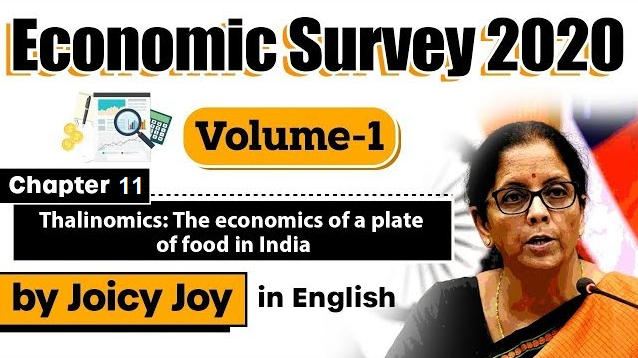Table of Contents
WHAT IS THALINOMICS
- An attempt to quantify what a common person pays for a Thali across India.
- “Thalinomics: The economics of a plate of food in India”
- Has a Thali become more or less affordable?
- Has inflation in the price of a Thali increased or decreased?
- Is the inflation the same for a vegetarian Thali as for a nonvegetarian one?
- Is the inflation in the price of a Thali different across different states and regions in India?
- Which components account for the changes in the price of a Thali – the cereals, vegetables, pulses or the cost of fuel required for its preparation?
WHY THALI
- As food is a necessity, a rapid rise in the price of a Thali has the most direct and conspicuous effect on the common man.
- Indeed, food and beverages constitute around 45.9 per cent in the Consumer Price
- The most effective way, therefore, to communicate the trends in prices to the common man is through the cost incurred in putting together one complete, homemade meal – the Indian Thali.
TREND
- Both across India and the four regions – North, South, East and West – we find that the absolute prices of a vegetarian Thali have decreased since 2015-16 though it increased during 2019
CONSTRUCTION
- Thalis were constructed using average monthly price data (used for preparation of Consumer Price Index-Industrial Workers (CPI-IW)) for the period April 2006 to October 2019 from Labour Bureau, Government of India, for 78 centres in 25 States/UTs.
- Average monthly prices of various commodities are averages of the open market prices of specified variety of an item prevailing in the selected outlets in the selected markets in a given centre.
- For rationed items, the prices for the centres are weighted average prices, the weights being the proportion of the quantity available through Public Distribution System and quantity procured from the open market in different centres in relation to base year (2001) requirements of an average working class family.
- Two types of Thali were considered for the analysis: a vegetarian Thali and a non-vegetarian Thali
MAJOR INITIATIVES FOR ENHANCING PRODUCTIVITY


AFFORDABILITY
- While the price of a Thali indicates the cost of consuming a healthy plate of food, knowing whether prices are increasing or decreasing is not sufficient to infer whether the common person is better-off or worseoff.
- What is also important to see is how have the earnings of the individual changed during the same period of time compared to the prices of a Thali.
THALI INFLATION
- Thali inflation (year-on-year growth in Thali prices), which remained elevated during the initial part of the period of our analysis, has shown significant reduction.

FINDINGS
- Absolute prices of a vegetarian Thali have decreased significantly since 2015-16 across India and the four regions; though the price has increased during 2019-20.
- Post 2015-16:
- Average household gained close to Rs. 11, 000 on average per year from the moderation in prices in the case of vegetarian Thali.
- Average household that consumes two non-vegetarian Thalis gained close to Rs. 12, 000 on average per year during the same period.
- From 2006-07 to 2019-20:
- Affordability of vegetarian Thalis improved 29 %.
- Affordability of non-vegetarian Thalis improved by 18 %.
Economic Survey | Free PDF






















 WhatsApp
WhatsApp